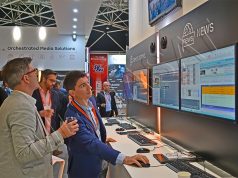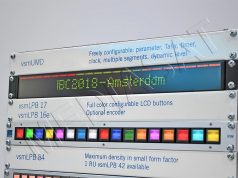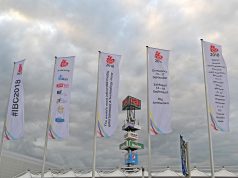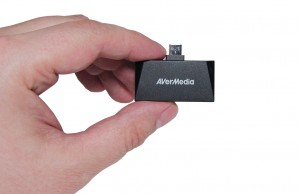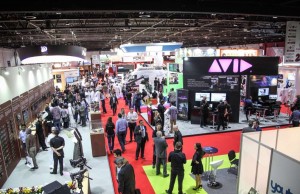The IBC 2015 Electronic Media Exhibition is traditionally visited by experts from around the world. This year’s event was held on September 11-15 and gave the gift of not only the warm sunny weather, but also of interesting presentations and contacts within the show. Moreover, some announcements were made a few days before the official inauguration of the exhibition.
And even in spite of the completely blocked traffic of land transport for a couple of hours one day in the city center, in view of protests against … the problems in the Dutch health sector, the visitors managed finding alternative ways to the RAI Expo Centre. In the worst scenario, the central train station is not so far away from the exhibition venue, i.e just near an hour of walking and contemplating colorful local views: the Musketeers (Rembrandt Square), channels with a floral design of bridges, antique architecture, lively street traders in markets (e.g. the famous flower market), and other local sights.
The IBC 2015 broke the attendance record again, compared to the IBC 2014, although not so important. The number of visitors at the event amounted to 55128, exceeding (though only by a fraction of a percent) the last year’s event. The area of participant stands in all 14 pavilions totalled 50 thousand square meters and hosted over 1800 companies.
This time, the outdoor exposition was expanded by a new open air pavilion, where manufacturers of flying multi-wings (drones) demonstrated the potential of aircraft gaining more and more popularity in the TV industry in recent years. The similar mini-pavilions were arranged inside the Expo Centre. In addition, the competition called Hack Fest was organized for the first time for fans of picking someone else’s code, and the organizers assigned a separate area for hackers in one of the pavilions.
The software and hardware designers, satellite operators, specialized research institutes, analytics companies and other exhibitors exposed a set of solutions aimed at receiving, processing, transfering, visualizing and protecting content for various devices. In fact, the standards for the TV industry become technologies like Ultra HD (4K), HEVC/H.265, MPEG DASH. But the most notable trend of this year’s exhibition one may call the increased interest of designers to the technologies like HFR (high frame rate up to 60/120 f/s) and HDR (High Dynamic Range) aimed at increasing the colour and brightness range of images and displaying improved (in fact richer in contrast) videos on high-brightness HDR monitors. Among other trends there are the promotion of multiscreen and slow motion relay, video post-processing, cloud technologies for content and further hybridization of devices.
What was of interest at the IBC 2015? The organizers did their best to offer not only comfortable stands to the participants, but also an entertainment show, including an evening cowboy-style party.
However, given the trends in 3D stereo movies, the cinema releases within the IBC Big Screen 2015 were somewhat surprising. This time, the visitors were offered the standard versions of the Fantastic Four and… the cartoon Inside Out (I did not think that the cinema hall would have been so packed). The screening was organized by applying high-brightness laser projectors Christie 6p, so the cartoon version was intentionally adjusted for the IBC platform and made in an extended color gamut, which caused a storm of applause after screening.
Set-top boxes and receiving Subscriber UNITS
I was pleased to find familiar brands among the exhibitors, which had not taken part in the exhibition for the first time. There was the company Infomir among them, the products of which are distributed in 106 countries around the world, and the number of countries where the products are actually available has near doubled in 2012 – 2015. The Infomir together with the SoftAtHome started cooperating in order to integrate the latest generation software SOP7 (the SoftAtHome’s design) into the set-top box MAG352, equipped with the superpower chipset Broadcom. It allowed designing the best solution for providing 4K-content and expanding the list of services to offer by operators.
The Infomir’s representatives recorded an increased interest of visitors in the company’s products, which was proved by numerous meetings with actual and potential customers from all over the world, who travelled a long way to be the first to see and test new products under the MAG brand. For example, the customers from the MENA region got a welcome surprise by learning that the Infomir had opened a representative office and logistics center in Dubai. It would allow minimizing the time required for processing orders and delivering end products throughout the region. In addition, the Infomir plans to take part in the TV Connect MENA 2015.
The Infomir announced several models at the exhibition. So, the advanced 4K HEVC set-top box of MAG352 premium based on the processor Broadcom BCM7252s, being the fist in the world to support the content protection technology VideoMarkTM by Verimatrix, is anticipated in the 1st quarter of 2016. There are built-in Wi-Fi 2.4/5 GHz and optional Bluetooth 4.0. The solution is provided with 2 GB of RAM, the largest memory capacity among those available company’s solutions. The set-top box is run by Linux 3.3 and optionally by Android. The watt consumption is 12 W.
The model MAG257 supports tecnologies HEVC and VideoMarkTM Forensic Watermarking by Verimatrix, enabling to watermark output videos (anticipated in the 4th quarter of 2015). The set-top box MAG257 is designed with the chipset STiH301 (1,5 GHz) and provided with a built-in Wi-Fi 2,4/5 GHz and two USB-ports. The model is an upgraded version of MAG254, the best solution for OTT/IPTV projects, recognized in over 100 countries.
The next innovation is MAG277 (anticipated in the 1st quarter of 2016), and it is a hybrid STB supporting DVB-C/T and IPTV/OTT. The model is run by Linux 3.3 and designed with the chip STiH301 1,5 GHz, supporting HEVC with built-in Wi-Fi 2.4/5 GHz; VideoMarkTM by Verimatrix; Ethernet 1 Gbit/s.
By the end of the year it is anticipated another OTT/IPTV-MAG350 model announced at the exhibition and designed for operators providing TV services via IP networks. The set-top box is designed with the chipset Broadcom BCM7250, supporting HEVC and having 8 GB of memory. The model is run by Linux 3.3 and optionally by Android. There are integrated Wi-Fi 2,4/5 GHz, USB, Ethernet 1Gbit/s. It also supports 3D-video playing.
The increased interest was generated by the updated software Stalker Middleware. The taste of visitors was suited at the stand by a new user interface and high performance of applications, the Infomir managed to obtain due to a new architecture. A real surprise for the visitors became the presentation of new applications catalog with dozens of worldwide popular video services available right at the moment.
By providing its subscribers with access to applications, the operator reduces simultaneously the load upon its infrastructure, and gains an additional competitive advantage. It was also presented a special software package for designers, which allows designing applications in a few days, to be available around the world to many thousands of service providers using Stalker Middleware.
It is also of interest the presentation at the stand of Abox42 (Germany) of the new platform Smart STB M40 based on the chipset Broadcom BCM7251s that meets the growing consumer demand for the Ultra HD content. The solution supports HEVC (up to 4K inclusive and frequency up to 60 f/s). The solution has an optional Wi-Fi 802.11ac, Ethernet 1 Gb/s, USB 3.0, Bluetooth 4.0. The devices are equipped with built-in HDD (up to 2 GB) and can record video to the external HDD via USB. The Solution M40 supports Verimatrix VCAS, SecureMedia and others. The hybrid M40 versions are available for DVB-C/T/T2/S/S2.
The joint stand of the Dutch companies IBDL and Dune HD presented a new STB model under the brand COOD-E based on the chipset Amlogic S805 (the quad-core Mali-450 GPU, 1 GB of memory, EUR 99). The model supports Wi-Fi 802.11 b/g/n, Bluetooth, USB, HDMI, Ethernet. It also supports HEVC. The solution is implemented in the KODI software. The interface is localized in many languages, including Russian and Ukrainian. As for Ukraine, the model is anticipated in November.
Another innovation was presented under the brand NEXXT – NEXXT PC Stick (EUR 159), weighing 265 grams and based on OS Windows 10. The system memory is 2 GB DDR3, 32 GB of flash memory for storage (Micro SD-card expandable up to 128 GB). The solution uses the processor Intel Atom Z3735F 1,33 GHz, and the GPU core is based on Intel processor. There are HDMI, USB, Wi-Fi 802.11 b/g/n, Bluetooth.
In view of the unit’s maximum heating temperature less than 34 degrees, the device does not require cooling.
The Russian company SmartLabs presented a new high-performance set-top box in a new ultra-compact case SML-Stick weighing just 45 grams and Linux-based with built-in 512 MB of memory (DDR3) and 256 MB (on a USB flash drive). It supports Ethernet, USB, HDMI, Wi-Fi 802.11n, PiP. The max resolution is 1080p60.
The HwaCom Systems under the brand Amaze TV (Taiwan) presented two STB models: M6020 and J3700 4Kp60 Android OTT Box.
Both solutions support 4K HEVC /H.264. The model M6020 supports USB 3.0, Ethernet 1 Gbit/s. There is an integrated tuner DVB-S/S2.
The TVIP LLC (tvip.ru, Russia), a new participant at the IBC 2015, presented STB TVIP S-Box v410/412 run by Linux/Android 4.4 and based on the chipset ARM Cortex A5 1,5 GHz (4GB of flash memory and the quad-core Mali-450 GPU). It supports FullHD, HDMI, Ethernet and optional Wi-fi 802.11b/g/n. Another model is STB TVIP S-Box v.500 with the same specifications, but having a small difference like availability of S-PDIF/Coax.
The Coolech Technology (China) under the brand Nemo Box 2 announced its Mg-Q solution (OTT, photo), which is anticipated in a month. The Box is designed on Android 4.4, Cortex A5 1,5 GHz (Amlogic S805) and Mali 450. There are USB, built-in Wi-Fi 802.11 b/g/n, and it supports H.264/H.265 (1080p).
The Yao Jin Technology (China) presented several models with USB support, EPG function with storage for a week, SD/HD, MPEG-2/MPEG-4/H.264: FTA STB model 1214 (DVB-T/T2/C, ATSC, ISDB-T), and a compact DVB-T2 dongle (Full-HD).
The Sichuan Changhong Electric (China) presented a prototype HEVC DVB-T2+S2 Combo with USB and Ethernet support, to be available in a few months.
The Huawei Technologies presented OTT/IPTV solution EC6108V9(B) based on the chipset Hisilicon 3798M and ARM Cortex-A7 with the quad-core Mali 450 GPU.
The Model based on Android 4.4 supports H.264/H.265, SD/HD (4Kp60), CAS Verimatrix.
The Sagemcom (France) presented the model 4K UHD IP STB based on the chipset BCM7252s (anticipated in November 2015), as well as the range of prototypes 4K UHD Concept STB. Unfortunately, the company did not permit to take pictures.
The Korean Intek Digital demonstrated its hybrid zapper HD-C76CX with DVB-C/C2support, designed for one of the Baltic providers.
The solution is equipped with USB and supports CAS Conax, VOD.
The Amino Communications demonstrated its model of hybrid media server C5060 with 4K/HDR support (to be available in the 4th quarter of 2015), as well as 4K-model A170, anticipated in the 1st quarter of 2016.
The KaonMedia (Korea) presented its 4K UHD Android TV.
And the Hexaglobe (France) demonstrated a new STB for advertising in coffeehouses, bars and other crowded places.
Among the innovations we should also mention the Conax, which presented a preview version of new STB based on the chipset Marvell and supporting 4K on OS Android 5.1, Wi-Fi, HDMI, and USB.
At its stand the Conax together with its partner iWedia demonstrated the operation of a hybrid STB, which ensures content protection for the pay-TV operators facing the option for the next generation platforms.








